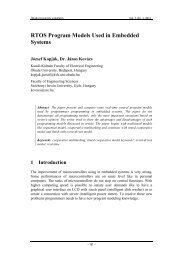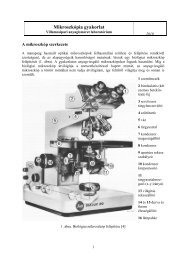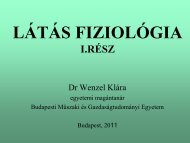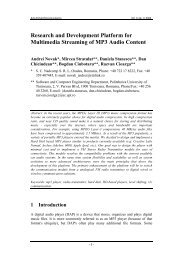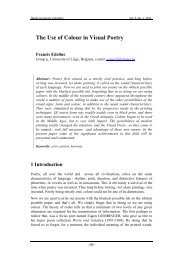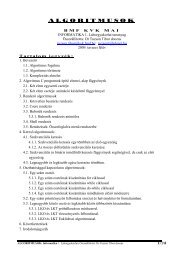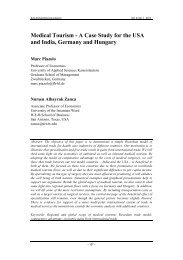Heart Rate Analysis and Telemedicine: New Concepts & Maths
Heart Rate Analysis and Telemedicine: New Concepts & Maths
Heart Rate Analysis and Telemedicine: New Concepts & Maths
You also want an ePaper? Increase the reach of your titles
YUMPU automatically turns print PDFs into web optimized ePapers that Google loves.
S. Khoór et al. <strong>Heart</strong> <strong>Rate</strong> <strong>Analysis</strong> <strong>and</strong> <strong>Telemedicine</strong>: <strong>New</strong> <strong>Concepts</strong> & <strong>Maths</strong><br />
R-wave detection (smooth – first derivative – largest deflection), the signal<br />
averaging in all time windows around the detected R-waves, the determination of<br />
template QRS by averaging the deflections in the corresponding time. For the<br />
measurement of complexity [15-17], the Grassberger-Procaccia Algorithm (GPA)<br />
was used, its main principle is to determine the correlation dimension using the<br />
correlation integral.<br />
The CI of a (chaotic) deterministic system is given by<br />
Cm(r) = Ar D e -mldΔtK ,<br />
A is a constant, D the correlation dimension, K is the correlation entropy, m the<br />
embedding dimension, l the embedding delay <strong>and</strong> Δt the sample interval.<br />
Cm(N,r)= 1/Ndis Σi={i_ref} Σj= /i/ >=W Θ( r-|x(i)-x(j)| )<br />
where N = L-(m-1)l is the number of delay vectors resulting from the time series of<br />
length L in reconstructed phase space of embedding dimension m. The Heaviside Θ<br />
(theta) is 1 for positive arguments <strong>and</strong> 0 otherwise. The inner sum counts the<br />
number of delay vectors within a distance r from a reference vector. The outer sum<br />
adds the results over a set {iref} of reference vectors <strong>and</strong> the normalization factor<br />
Ndis is the total number of distance involved int he summations. We used 10000<br />
r<strong>and</strong>omly chosen reference vectors, which is equal to one third of the number of<br />
samples int he time series (sampled down to 30000 samples) as suggested Theiler.<br />
The steps of the GPA were:<br />
- The Correlation Integral (Cm(r)) dimension for different embedding<br />
(delayed) dimension (m) is calculated.<br />
- If (Cm(r)) shows scaling (=linear part on double logarithmic scale) the<br />
Correlation Dimension (D) <strong>and</strong> Correlation entropy (K) are estimated with<br />
coarse-grained Dcg <strong>and</strong> Kcg.<br />
- If (Cm(r)) shows no scaling a distance r <strong>and</strong> an embedding dimension m are<br />
chosen at which the coarse-grained Dcg <strong>and</strong> Kcg are estimated. Figure 4<br />
shows the Correlation Integral (Cm(r)) dimension for different embedding<br />
(delayed) dimension (m); if (Cm(r)) shows scaling (=linear part on double<br />
logarithmic scale) the Correlation Dimension (D) <strong>and</strong> Correlation entropy<br />
(K) are estimated with coarse-grained Dcg <strong>and</strong> Kcg.<br />
The amplitude values of CI, CD, CE at various m were determined with their<br />
coarse-grained values. The DSC model selects the best parameters stepwise, the<br />
entry or removal based on the minimalization of the Wilks’ lambda. Three<br />
variables remained finally: x1=CI mean-value at log(r)=-1.0 (m9-14), x2=CI meanvalue<br />
at log(r)=-0.5 (m12-17), <strong>and</strong> x3=CD_cg. The Wilks’ lambda was 0.011, chisquare<br />
299.68, significancy: p




